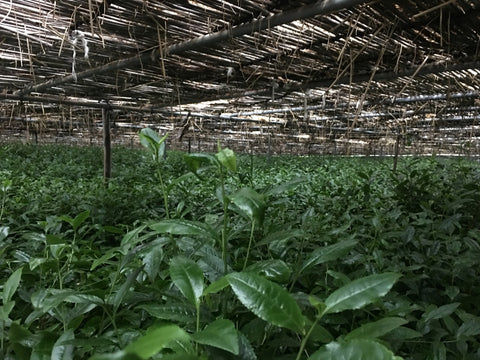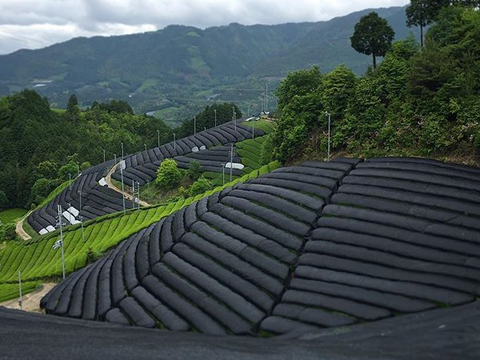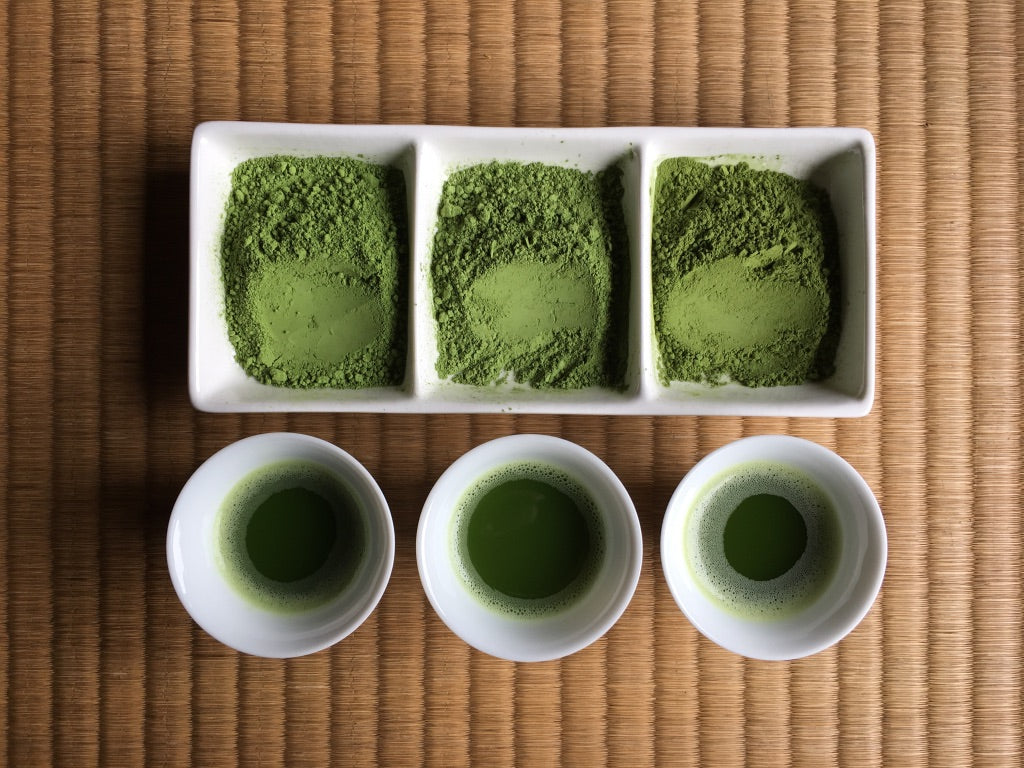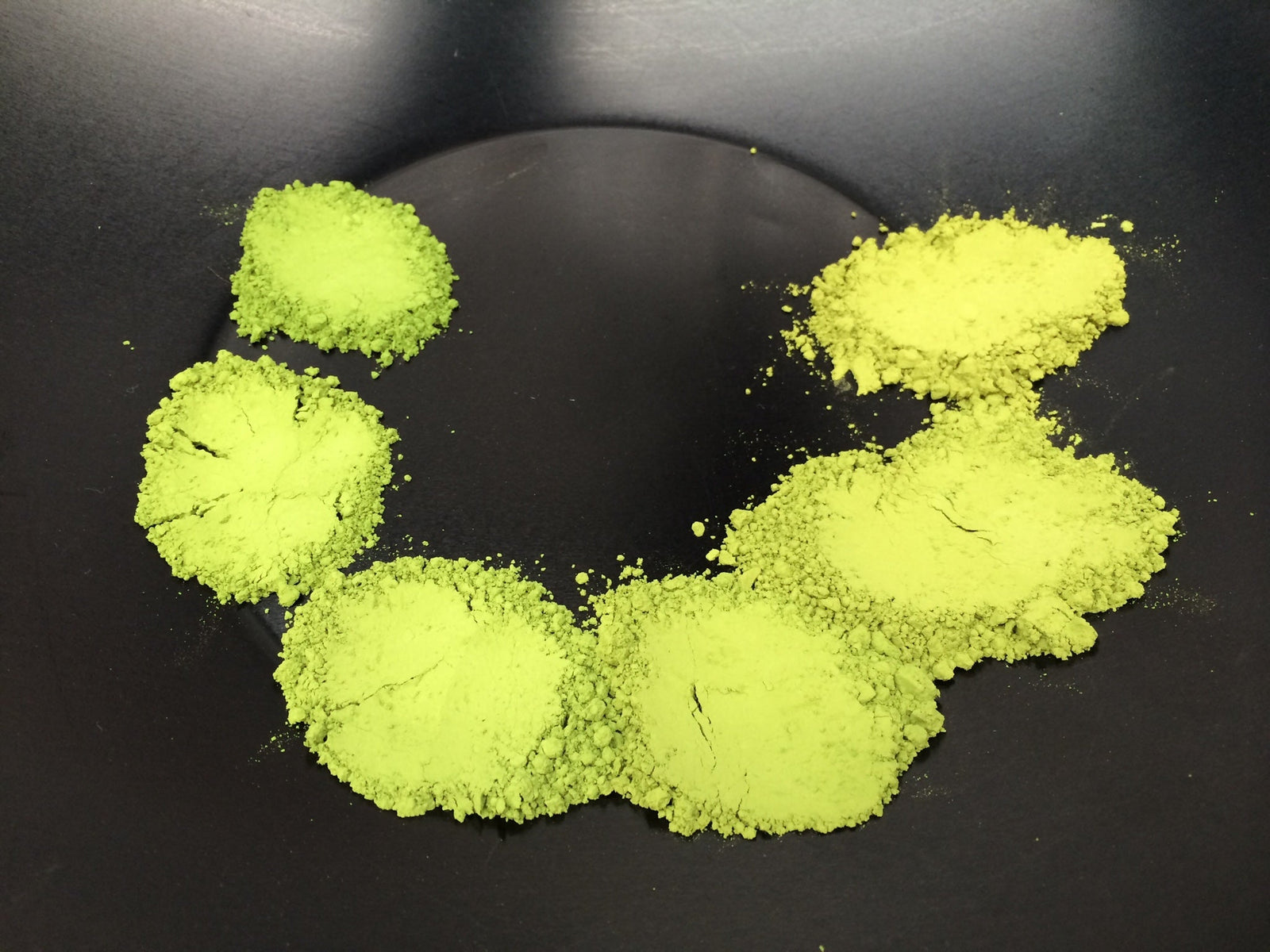A customer recently asked on another blog post, “With the bitter taste of matcha tea is there a way to make it taste better?” The customer had referenced Uji Hikari Matcha, which is a specific cultivar like Merlot for wine.
The easy and quick answer is: add milk and sugar, turning whatever quality matcha you have into a latte that is sweet and creamy.
The more subtle answer is to use the right water (soft) at the right temperature (70-80C/160-175F degrees).
However, there are a few things to understand about the flavor of good quality matcha and how that flavor is achieved.
Specific cultivars are the very last thing to consider when considering flavor. So we will come back to a discussion on cultivars later.
Shop our collection of matcha & other tea powders
Putting aside certain life philosophies promoted by specific schools of tea ceremony (a subject for a different blog post), the matcha industry in Japan general considers the following when determine the quality go matcha:
- Flavor: high level of umami flavor & low level of bitterness and astringency,
- A smooth texture (smaller grain size). Good, “ceremonial” quality matcha should be about 5 microns in size, resulting in a matcha that is not gritty in your mout. Culinary grade matcha is generally 15 microns and will feel gritty. We have heard of non-Japanese “matcha” that is as large as 25 microns...
- Bright green color of powder, deep green matcha color
- Rich aroma
- Foam or froth is actually not much of a consideration in Japan as this is mainly a feature requested by the Urasenke tea ceremony school (by far the largest, most international and therefore most influential outside Japan)...but for our purposes easy frothing with fine bubbles for extra creaminess should be a result of high quality.
Cultivation Techniques
Fertilization, Shading, Catechin & Theanine
While the tea leaf has thousands of compounds that make up flavor, we can think of two major groups - catechin (antioxidants) that create the bitter flavor of matcha and L-theanine, an amino acid, that creates the umami flavor. The tea leaf loses theanine and creates catechin as it grows and is exposed to sunlight. This is why leaves for matcha is shaded, to increase the umami flavor and reduce the bitterness (which also makes it less “healthy” than it would have been otherwise).
Farmer/ who grow leaves for high grade matcha will also infuse the field with fertilizer, mainly nitrogen, in order to have as rich of a flavor as possible. The major problem with organic matcha is that to avoid damage from insects attracted to heavily fertilized (therefore delicious, nutrient rich) tea leaf, less fertilizer is used. Meanwhile pesticide reliant fields can be infused with fertilizer to produce the richest leaf because pesticides can be used to manage insects attracted to the leaves.
There are two major types of shading: canopy shading and direct shading using plastic. Canopy shading allows the plants to grow freely, which the requires laborious handpicking to harvest the leaf. Those farmers making the best leaf do this and tend to their fields year round by hand to create award winning leaf. Before the spring flush of new leaves, for example, farmers will pluck the apex bud off each branch in order to force lateral growth of new buds atop existing base leaves—these new buds become the highest quality leaves for both matcha and tencha.
Images (left to right): Traditional canopy shading (Yunomi's production partner's contract tea farm), canopy shading with plastic shading material (Nishide Tea Factory's partner farm), direct shading with plastic shading material (Obubu Tea)


Very traditional canopy shading involves the use of some kind of straw material that is layered gradually over the course of 4 weeks decreasing the amount of sunlight passing through as the leaves grow, and allowing the farmer to adjust the amount of sunlight very subtly.
Machine harvesting, besides being much more efficient, through allows you to form a hedge from your field, creating a shape that makes it easy to place shading directly onto the plant. While much easier than canopy shading, the pressure on the leaves and the potential for damage from flapping against the leaves reduce leaf quality.
Finally, the length of shading also contributes to higher quality leaf, reducing the amount of catechin and maintaining theanine levels, but also hinders leaf growth, which results in lower crop yield and therefore a higher price. While 4 weeks is a general length of shading time often quoted, lower quality leaf may be shaded for as little as 14 days while higher quality can be as long as 40 days.
I'm going to note here that there are other factors in cultivation that might affect quality, but leave this for another discussion: weather in the months and weeks leading up to harvest, climate, soil, region, etc.
Harvest Season
The spring harvest season is when the leaves have the most amount of nutrients, creating the most flavor—rich and creamy if shaded right, and more bitter if not. In fact in Japan, unshaded leaves are ground to form an antioxidant rich green tea powder (never called matcha in Japan since they are not made from shaded leaves). Other harvest seasons are also used for matcha and tend to be more bitter because the leaves are allowed to grow longer to be harvested at a larger size, increasing crop yield. If harvested at the same size as spring, the crop yield is not only too small, but the leaves are not as nutrient rich so the flavor is also less powerful. Summer and autumn harvested leaves are there generally used for culinary grade matcha in Japan. However since there is no explicit standard, particularly outside Japan, unscrupulous or uninformed sellers may sell matcha as “ceremonial grade” even when it would not be accepted as such in Japan.
Grinding
Tencha Cultivar Tasting Set by Shogyokuen Another factor affecting quality of flavor, color and aroma is how the tea leaves are ground into matcha. The very first step is to turn raw leaves into dried leaves to be ground into matcha. That dried leaf traditionally is called tencha, and is made basically by steaming freshly harvested shaded leaves, then drying on a rack through a specialized oven. The brittle leaves are then crushed to form flakes, and in this process stems and veins are sorted out. Those flakes, tencha, can then be ground into matcha.
Another factor affecting quality of flavor, color and aroma is how the tea leaves are ground into matcha. The very first step is to turn raw leaves into dried leaves to be ground into matcha. That dried leaf traditionally is called tencha, and is made basically by steaming freshly harvested shaded leaves, then drying on a rack through a specialized oven. The brittle leaves are then crushed to form flakes, and in this process stems and veins are sorted out. Those flakes, tencha, can then be ground into matcha.
However, processors who don’t have the special oven have been able to produce a dried leaf using standard sencha rolling machines combining sped up drying and loose rolling. This dried leaf, called mogacha can then be ground into a coarse matcha. Since the production can be done in large quantities and used for lower quality matcha, it can be mass produced more efficiently than the traditional method.
Finally, grinding can be made with traditional stone mills (30kg stone mills with grooves carved specifically for tencha grinding, and hooked up to motors for automation), or pulverization machines (ceramic ball mills or jet air pulverization). The stone mill process is generally slow, with less than 500g produces over a 10-hour work day, and produces the finest grain. Factories can use a higher rotation speed to produce a larger volume more quickly with a coarser grain, but with the availability of higher volume pulverizers, there is little reason to do so.
Likewise, these pulverization machines are generally used for lower quality matcha because of greater volume (20kg-100kg per day per machine), but can produce stone mill level grain size at 1-5 microns if required. However given the exact same tencha leaf, and despite advances in cooling systems for the machines, stone mills do retain better color and aroma for the matcha.
Storage
Another factor affecting quality of flavor, color and aroma is storage. The harvest year of the leaves is often less important than the age of the matcha since grinding. In fact the best leaves are allowed to age 6-12 months in order to allow the catechin to breakdown. But once ground into powder the matcha loses flavor, color and aroma quickly—even with proper airtight, dedicated refrigerated storage, you can notice a difference in color and aroma after 6 months (so the best matcha often have 6-month best by dates) if doing a side by side comparison. 12-month best by dates are standard though, but even then manufacturers assume their clients are storing properly, when many of them are likely using warehouses without temperature control, that can get hot in the summer. This is a major reason for bad quality.
Cultivars
Specific cultivars are the most subtle factor that affect quality, although a side-by-side tasting can show the obvious difference if you can control for all the other factors. Controlling for all other factors is very difficult as even the same farmer will have different cultivars on different fields, and those fields may be exposed to different environmental factors. But given this consideration, when you compare cultivars of matcha produced by the same farmer, you see a difference.
Yabukita - is often found in matcha simply because 75% of the tea grown in Japan is Yabukita. The Yabukita cultivar is a hardy plant that allows for a good sencha and for this reason has become the industry's standard. But the plant's leaf produces less theanine and therefore less umami flavor, and a duller green color. See the below photo from the Azuma Tea Garden.
From right to left: Okumidori ("deep green"), Samidori ("early green" - the green of young leaves), Yabukita ("north of the grove" - named simply after the location where the original plants were raised)

Examples of types of cultivars used for matcha are below, and often have a better color, or richer umami flavor, than yabukita. However, the reasons for growing multiple cultivars are not only limited to the end product; farmers manage risk against disease and pests by growing multiple types of tea plants, and stagger harvesting because different cultivars are ready for harvest at different times during the harvest season. Still, for those who are deeply interested in matcha, being able to compare different cultivars is very interesting.
Options: Azuma Tea Garden's cultivar comparison set, Obubu Tea's cultivar comparison set.
- Asahi
- Asanoka
- Gokou (or Gokо̄)
- Hо̄shun
- Kanaya Midori
- Samidori
- Saemidori
- Okumidori
- Okuyutaka
- Seimei
- Tenmyо̄
- Uji Hikari
- Uji Midori



2 comments
A very clear and comprehensive intro to Matcha. Thank You
Super interesting, thank you for sharing ! I am a wine nerd, so this is really similar to wine for me.